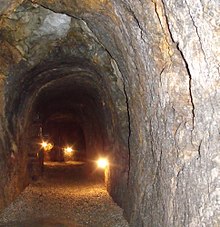Peniger cellar mountains
The Peniger Kellerberge are a system of underground passages in Penig .
location
The longest accessible corridors are in the north of Penig, between Leipziger Strasse and Uhlandstrasse in the Altpenig district. There are also smaller facilities on the Hühnerberg, the so-called "robber tunnel" and within the old town.
investment
The corridors were carved out of mica-schist gneiss . The part that is accessible today is about 2000 meters long. They form a labyrinth in three levels. From the main paths, many arcuate or short, blunt-ended passages branch off on both sides. At the entrance to these corridors, joints in the rock indicate that they were previously closed by doors. Individual signs with numbers are also still preserved. Often there are niches for figures of saints and fist-sized recesses for receiving lights. Some smaller rooms are also available. The corridor system had ventilation and drainage. The drainage is solved simply and effectively. The penetrating water collects in pits and passages and seeps away from there.
history
The first reference to the cellar mountains can be found in Peniger chronicler Sebastian Meyer in 1549. Most contemporary authors interpret it to mean that the corridors were laid out in 1511 by the brothers Wolff and Peter Rodten. Emil Berger, who examined the corridors in 1926, believes that the brothers only expanded existing corridors.
In 1856, the Rochlitz administration had part of the corridors filled.
Around 1926 the corridors were rediscovered and examined by friends of their homeland. A year later, for the 700th anniversary of the city, some of the corridors were made accessible again by the owner of the property. In 1933 they were prepared for air raid protection by the voluntary labor service.
Shortly before the 750th anniversary in 1977, citizens found themselves again who made the corridors accessible again at about five hundred meters. In 1978 a hat house was built. This time they stayed open until 1990, when security measures forced them to close again. The Schneeberg mountain security reinforced pillars, secured tunnels and renewed ventilation. In 1995, the day of the Saxons , the corridors were reopened.
In 2002 the entrance was moved to Leipziger Straße and in July 2004 a new hat house was inaugurated. There is also the "Peniger Heimatberg", a model of the city of Penig in the style of the Erzgebirge Christmas Mountains .
Origin and use
The origin and purpose of the cellar mountains is not clear. Speculations that it is an old refuge are now considered unlikely. Another legend says that the basement mountains are connecting passages between a monastery and a nunnery. However, there is no evidence for these monasteries.
It is more likely that it is an old mine. In fact, mining was practiced a few kilometers up the trough in Zinnberg around 1500. When the veins were explored in 1926, traces of lead and silver ore were found in the rock .
The mountains of cellars are said to have been used as a beer cellar later. Because of the uniform temperatures of 8 to 10 degrees, they would be suitable for this. However, storage in barrels is not possible due to the narrow aisles. According to contemporary witness reports, they were certainly used as storage cellars until the 20th century, at least by the owner of the property.
Comparison with other gait systems
Several other cities in Saxony, such as Glauchau , Lichtenstein , Meerane and Waldenburg, have underground passages. In contrast to the Peniger basement mountains, they do not form a coherent system, but have their starting point in the cellars of individual houses. The Peniger Kellerberge are today on the outskirts of Penig, but in 1511 they are far from the gates of the city on the Altpenig corridor.
literature
- City administration Penig (ed.): 775 years of Penig, 14.-23. June 2002, Festschrift. Miriquidi-Verlag 2002. ISBN 3-9806774-9-4
- Home and history association Penig and environment eV (Ed.): The cellar mountains to Penig. 2004.
Web links
Individual evidence
- ↑ "Seindt apparently invented = found = discovered and accepted to bawen according to the identification of the old town book, ie repaired, broken-in corridors were clogged and covered with quarry stones and with clay by two citizens and brothers here, namely Wolff and Peter Rodten Anno 1511" quoted in Emil Berger Descriptive representation of the cellars or earth passages of the outer Uhlandstrasse as well as at the old bridge gate in history sheets , special supplement to the daily newspaper for Penig and Lunzenau in an informal sequence , No. 11/1926.
- ↑ Emil Berger: Descriptive representation of the cellars or earth passages of the outer Uhlandstrasse as well as at the old bridge gate in history sheets , special supplement to the daily newspaper for Penig and Lunzenau in informal series No. 11/1926
- ↑ Ernst Bolz: Half a year of voluntary labor service in the steel helmet camp Penig in history sheets, supplement to the daily newspaper for Penig and Lunzenau No. 19 1933
- ↑ The Peniger Kellerberge, a unique attraction of its kind, were made accessible again "Interview in Das Zahnrad, organ of the BPO of the SED VEB Getriebewerk Penig No. 7/8 June 1977.
- ^ Henning Haßmann : Labyrinths under West Saxon cities , in archeologie aktuell 4/1996, ed. from the State Office for Archeology with State Museum for Prehistory, Dresden. ISBN 3-910008-19-4
Coordinates: 50 ° 56 ′ 13 ″ N , 12 ° 41 ′ 55.2 ″ E

